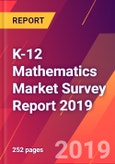K-12 Mathematics Market Survey Report 2019 provides information on the core and supplemental resources used by math educators for the instruction of their students. The data and analysis contained in the report will help math product developers and marketers learn more about K-12 math instruction so they can sharpen the focus of their product plans.
K-12 Mathematics Market Survey Report 2019 is based on a survey of educators during the 2018-2019 school year. The educators surveyed included classroom teachers, math teachers, math department chairs and instruction/curriculum supervisors.
Information provided in this report includes:
- Who are the leading providers of core and supplemental math resources
- How much of math instruction time is spent using digital tools or content
- What are the most important criteria when math instructional materials are selected
K-12 Mathematics Market Survey Report 2019 provides additional insight into:
- Whether schools are integrating science, technology, engineering, and math curriculum into a single STEM curriculum, and the methods used to accomplish that
- What math websites teachers are using or recommending for student use
- The level of interest among math educators in emerging areas, including project-based learning, educational games, coding, robotics, virtual/augmented reality and maker spaces
The 2019 report is one of a series of annual reports providing data on the choices schools are making as they select instructional resources for core K-12 subjects.
Table of Contents
1 Methodology2 Executive Summary
Samples

LOADING...
Methodology

LOADING...








